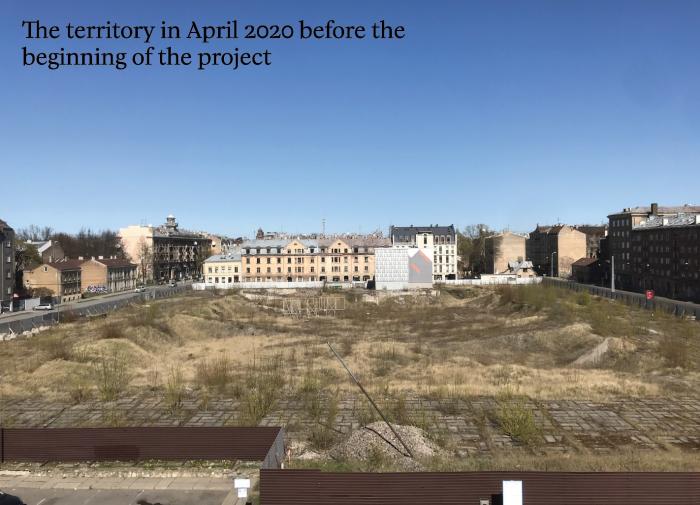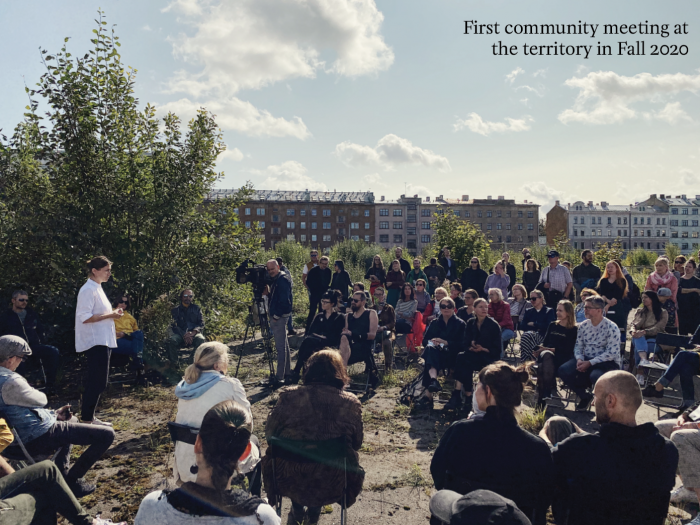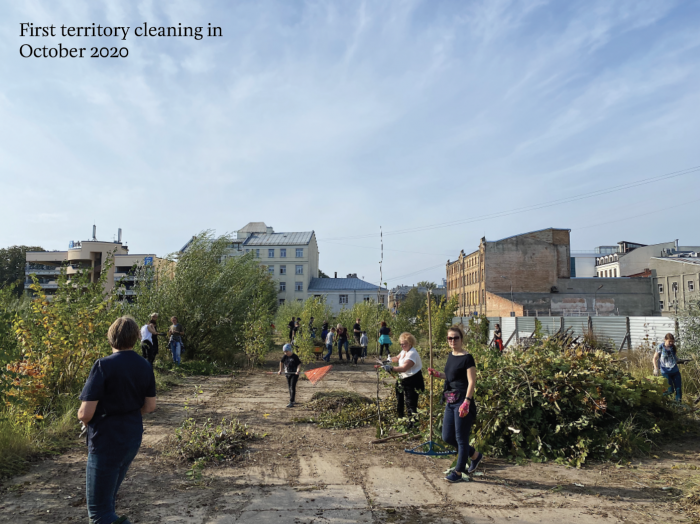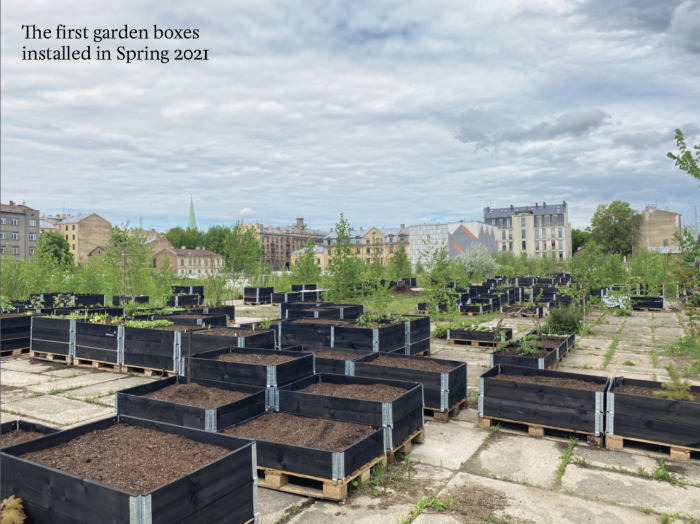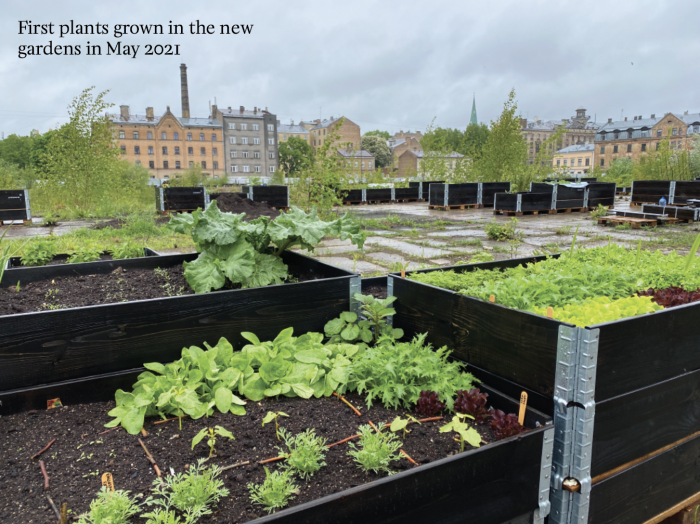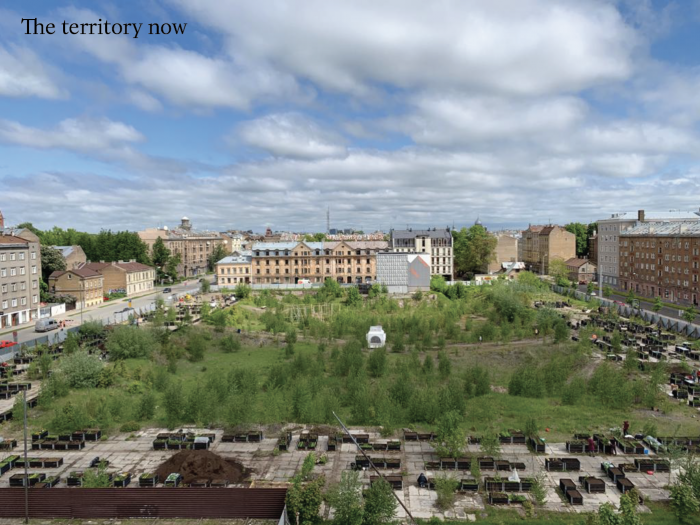I. SUMMARY INFORMATION
Project
268440
Status
Submitted
Award category
Regenerated urban and rural spaces
You want to submit
NEW EUROPEAN BAUHAUS AWARDS : existing completed examples
Project title
Sporta pils dārzi
Full project title
Sporta pils dārzi — The Gardens of Sporta pils
Description
Sporta pils dārzi is a non-profit project organized by the citizens of Riga to transform and, for the first time, open the former Sporta pils territory after its demolition in 2009. The project is the first example in the Baltics of how temporarily exhausted lots can become lush community gardens where social barriers are overcome by sharing and caring and involving civic society and public and private sectors.
Where was your project implemented in the EU?
Latvia
Riga
Kr. Barona iela 75
Rīga
LV-1001
When was your project implemented?
Has your project benefited from EU programmes or funds?
No
Which programme(s) or fund(s)? Provide the name of the programme(s)/fund(s), the strand/action line as relevant and the year.
II. DESCRIPTION OF THE PROJECT
Please provide a summary of your project
Sporta pils dārzi (Gardens of Sporta pils) is a non-profit project organized by the citizens of Riga to transform and, for the first time, open the former Sporta pils territory after its demolition in 2009. The project is the first example in the Baltics of how temporarily exhausted lots can become lush community gardens where social barriers are overcome by sharing and caring and involving civic society and public and private sectors.
While the 2-hectare territory awaits its development, the local community has made a unique agreement with its owners to repurpose the depleted lot for the use of community gardens and public park between Fall 2020 and 2023 or until the beginning of the construction.
The project aspires to set an example of how vacant lots can be turned into and activated as modern, empathetic, and essential spaces for community building and public use. The project's goal is to encourage the citizens of Riga to take an active part in the city's development and create a place and time for promoting a more healthy and sustainable lifestyle and offer a possibility for an educational and contemporary leisure time for the local community. Moreover, at the centre of its decision-making, the project holds a belief that beautiful, open and imaginative spaces contribute to a tolerant, creative and inventive society.
During the project's first stage, in the fall of 2020, the core team organized discussions with the local community about the project and joined more than 200 volunteers (now gardeners) to clean the territory after 12 idle years. This spring, the community installed the first 150 urban gardens and continues to heal the place to open it for public culture and educational activities later this summer and meet with other community members and share our vision and aspirations.
Please give information about the key objectives of your project in terms of sustainability and how these have been met
The project looks at sustainability from several perspectives — in terms of environmental preservation and the longevity of the project itself. In terms of environmental preservation, we made the decision that all gardening in the territory must be organic and no chemical fertilisers would be allowed for the community urban gardeners. Understanding the importance of the soil, we partnered up with EkoZeme — one of the most environment-conscious and highest quality organic soil producers in Latvia who provides high-quality chemical-free soil for our gardens. Actions in the territory are accompanied by regular workshops and lectures on eco-friendly gardening and the importance of reviewing our long-established habits. We keep this as our focus also when organising practical sessions on recycling that for many Latvians is an uncommon habit. We find it extremely important to discuss these issues in a non-didactic but empathetic and supporting way. The workshops are organised in collaboration with the Zero Waste movement, professionals and led by our own community members. Furthermore, besides setting up recycling bins in the territory, we have set up four compost boxes for biodegradable waste. Moreover, one-third of the raw materials used to build gardens, compost boxes and other constructions are secondary. And, both raw materials and detritus found in the territory are put for innovative use within our culture programme and gardening. It is similarly important for us to look at sustainability in terms of how the project can continue after the initial project timeline. We've been allowed to freely use the territory until 2023 or until the commencement of construction. We have found this uncertainty inspirational and every construction and element in the territory including our tool shelves and garden cafe can be easily transferred to another location to revitalise another vacant lot and bring together community.
Please give information about the key objectives of your project in terms of aesthetics and quality of experience beyond functionality and how these have been met
Aesthetics is one of the core values of the project due to three reasons:
The project believes that a beautiful and creative environment contributes to an open, tolerant and innovative thinking community;
Acknowledging that many community-led projects often lack resources to invest in design and thus might be disregarded by the public or private sector, the team was determined to set a new example on how to discuss community-led placemaking through open, honest and modern design.
The project aspires to contribute to a discussion about art in public spaces as a tool for placemaking and community strengthening. We believe that through public art and unorthodox landscape architecture, the built environment can become more open and foster sincere relationships between community members based on trust and care.
We've gathered a team of skilled professionals with a background in architecture, landscaping, contemporary artists, curators, and graphic designers to implement these notions. Together we have pursued sustainable, functional and aesthetically pleasing solutions for the project to transform the bleak and degraded territory into an unexpected, uplifting and encouraging oasis. We've balanced out the existing chaos of the territory with visually coherent elements - 150 urban gardens, tool shelves, shades, cafe, all sharing the same aesthetic. More importantly, this approach is also reflected in our graphic identity. At its basis is the grid of the layout of the territory, which carries the more romantic elements of nature, thus reflecting how the project brings new life to the demolished area and how people can bring life to the dreary and chaotic built and demolished environment. The graphic identity was created in close collaboration with Latvian artists. Furthermore, we have launched a collaboration with three amazing contemporary Latvian female artists that are creating unique site-specific artworks finding inspiration in the values of the project.
Please give information about the key objectives of your project in terms of inclusion and how these have been met
There are several inclusivity goals we've reached at Sporta pils darzi, which vary in form and group of people they've been aimed at.
One of the first goals of the project was the social inclusion of seniors living nearby the territory. Isolation of seniors is an unaddressed problem in Latvia, and since day one, we saw an opportunity for gardens to be a space and platform where seniors can feel confident and interact with people from various age groups and share their gardening skills with younger people. Around 20% of gardens are owned by people in their retirement, and we hope to invite even more seniors to join our community in the future through events and skill-sharing experiences. Territory accessibility is an inclusion objective similarly crucial for us since the beginning. Ten of our 150 gardens are custom made to be as comfortable for people using a wheelchair. We have partnered up with Apeirons — the most prominent non-profit organisation aimed at protecting people with disabilities in Latvia. Together with them, we've mapped out potential points of improvement that could make the project more accessible and are about to launch a workshop on how to interact with people with disabilities in a respectful manner that we hope will lessen the stigma around disability within our community. Another inclusivity challenge that is very acute in Latvia is the social segregation between Latvians and Russians. Since the beginning of the project, we've deliberately translated the communication, website, and most crucial information in Latvian and Russian, which is not common among new NGOs in Latvia. Similarly, we've emphasised inviting the Russian community to join our gardening project, which has led to at least 20% of gardens being owned by a person of Russian nationality. We strongly believe that due to the long tradition of gardening in Eastern Europe, community gardens are a ideal platform to bring people together despite their age, race, gender and nationality.
Please give information on the results/impacts achieved by your project in relation to the category you apply for
The biggest goal was to make an inactive and degraded 2-hectare territory suitable for public use, which we achieved in less than a year. We have opened up a quarter in the centre of Riga that was previously inactive and degraded and is now accessible for public use and gives way for urban citizens to be closer to nature. The territory that once consisted of construction debris and was deleted from the inhabitants' minds is now a place for more than 150 community gardens filled with flowers with more than 90 garden boxes open for public use and appreciation. The middle part of the territory - the pit, where once a hockey hall and supermarket stood, is turned into a public meadow where cultural events will occur, and anyone can take walks, organize picnics and rest in nature in the middle of the city centre.
Although the territory is located in the centre and is part of Riga's historical centre, the zone of the centre has been regarded as of less value and slightly dangerous. And thus, it lacks community gathering spaces and has served more as a transit zone than a public space for all. With the implementation of the project, we have created a unique place for public use - gardening, picnics, cultural activities, and have managed to alter the atmosphere and identity of this part of the city. This is also appreciated by neighbours of the location saying that neighbourhood has become much more friendly and pleasant.
Furthermore, we have served as encouragement for other similar projects. We have been approached by other communities with interest to develop something similar in their neighbourhoods. We find this one of the most significant achievements, as our goal has always been to encourage community building and see more projects like this grow in Riga. By revitalizing our 2 hectares, we have caused a snowball effect that will hopefully soon translate into similar projects in other parts of Riga and Latvia and the Baltics.
Please explain the way citizens benefiting from or affected by the project and civil society have been involved in the project and what has been the impact of this involvement on the project
The local community has been a part of the project ideation, building and decision-making since the beginning. At the start of the project, we organised a community meeting where all locals were invited to express their thoughts, concerns, and ideas regarding the territory, reasons for opening it public, and how they would like to participate. After the first community meeting,, almost 150 people instantly agreed to become volunteers for the first territory cleaning that happened last fall. Since then, the core team has made sure that all the decision-making includes the volunteers and community members through online community meetings and meetings on-site and encouraging members to become part of the team or trusting them with significant tasks. The community gardeners were also responsible for setting up both their gardens and public gardening boxes together in multiple workshops with the spring season.
Additionally, starting from June, all community members will also do shifts of neighbourhood watch. During their shifts, the gardeners will welcome the guests, share the idea of the project and the process and be ready to share the know-how of the project. Thus the gardeners will also serve as ambassadors of the project and its values. Moreover, all community members are also meeting regularly to discuss how to improve public access, ideas for art events and generally grow the project beyond this one location. The regular community meetings online are how decisions are made during times when it is impossible to meet in person, and all decisions regarding the territory are based on a voting system. Thus, we try to make sure that the civil society and all members are involved in all parts of the project implementation.
Please highlight the innovative character of the project
Sporta pils darzi is the first example in post-Soviet Riga when multiple stakeholders - civic society, municipality, and real estate developer - collaborate with an aim to increase the quality of the urban environment by using tools of community building. In this case the main tool is urban gardening that is also a rather new concept to Riga in a way that it has been practiced by Sporta pils darzi. This is the first time an urban gardening project has taken the size of a whole quarter which is not only new to Riga but Baltic States too. Similarly the project has been an educational tool regarding the mental and physical benefits of urban gardening that have been foreign to Riga before.
What is also innovative about this project is the way we have built a professional relationship not only with our partners, supporters and sponsors but also with the city of Riga. We have since day one practiced an organised and structured way of doing non-profit — from our visual identity to the way we approach sponsors and supporters, we feel the need to do it at the same quality we would do it if we were a for-profit company. This has lead many people to misleading image of Sporta pils darzi being funded by external stakeholders, yet in reality we have set an example of how a non-profit organisation can be seen as a serious force in building community, advocating for well-being of the citizens while maintaining a strong and honest relationship with sponsors and community members alike.
Please explain how the project led to results or learnings which could be transferred to other interested parties
We've identified at least two big stakeholders that have already benefited from he learnings of Sporta pils darzi and will undoubtedly learn even more in the future. The first one is the City Council of Riga as well as other municipalities in Latvia. The process of opening a previously inactive construction site to the public has included receiving permits from various municipal organisations that have highlighted the issues and complications many non-profit organisations might encounter when trying to build a similar project. From permits to use the city water to authorisation for building temporary objects within the territory we've noticed a lot of challenges that can easily be compiled in guidelines for cities on how to foster the creation of similar non-profit projects that might otherwise be too intimidated to exist under the heaviness of bureaucracy.
We have also emphasised the potential for city tourism in urban gardening projects. The pandemic has highlighted the importance of open-air activities that could not only provide entertainment for locals but act as objects of sightseeing. Urban gardens perfectly fill this gap and offer a public space that strengthens the community as well as attracts visitors.
Various district unions are also beneficiaries from the learnings of this project as they can now use Sporta pils darzi as a case study for ways of strengthening community in their local territories. Already at this moment Sporta pils darzi has inspired at least two other similar community gardening projects — one in a more rural territory of Riga and the other one in Liepaja, the third biggest city in Latvia. They have similarly convinced the community as well as most important sponsors to support a project that works so well in solving many community issues the city itself or other governmental organisations don't have the capacity to solve.
Is an evaluation report or any relevant independent evaluation source available?
No
III. UPLOAD PICTURES
IV. VALIDATION
By ticking this box, you declare that all the information provided in this form is factually correct, that the proposed project has not been proposed for the Awards more than once under the same category and that it has not been subject to any type of investigation, which could lead to a financial correction because of irregularities or fraud.
Yes
